What Was the Art Like for the Ancient Inuit Peoples

This picture shows several Inuit constructing an igloo with blocks of snow.
Click on image for full size
Library of Congress Prints and Photographs, Photo past Frank E. Kleinschmidt
Inuit Culture, Traditions, and History
Traditional Inuit style of life was influenced by the harsh climate and stark landscapes of the Arctic tundra � from beliefs inspired by stories of the aurora to practicalities like homes fabricated of snow. Inuit invented tools, gear, and methods to help them survive in this environment. Read on to learn more about traditional Inuit ways of life, and how Inuit culture has been changed over the past century.
Geography
Inuit communities are found in the Chill, in the Northwest Territories, Labrador and Quebec in Canada, to a higher place tree line in Alaska (where people are chosen the Inupiat and Yupik), and in Russian federation (where people are called the Yupik people). In some areas, Inuit people are called �Eskimos� however many Inuit observe this term offensive. The discussion �Inuit� means �the people� in the Inuktitut language.
Inuit Homes
In the tundra, where Inuit communities are found, there are not many building materials. No trees grow in the tundra so houses can not be made from wood unless it is transported from elsewhere. However, during a large function of the year, the cold part, there is a lot of snow in the tundra. And it turns out that snow can be a very good construction material. In the winter, Inuit lived in round houses made from blocks of snow called "igloos". In the summer, when the snow melted, Inuit lived in tent-like huts made of fauna skins stretched over a frame. Although well-nigh Inuit people today live in the same community year-round, and live in homes congenital of other structure materials that have to be imported, in the by Inuit would migrate between a summer and winter campsite which was shared by several families.
Getting Around
To travel from 1 identify to another, Inuit used sleds made of animate being bones and skins pulled over the snow and water ice by dogs. Strong dogs with thick fur like huskies, bred by Inuit, were used. On the waters of the Arctic Bounding main, small boats called �kayaks� were used for hunting while larger boats called �umiaq� transported people, dogs, and supplies.
Finding Food
Because Inuit live in places where most plants cannot grow, the traditional diet consisted of virtually entirely meat. Inuit fished and hunted to get their food. Whales, walruses, seals, fish were staples of their diet.
Clothing for Staying Warm
Traditional Inuit clothing was made from animate being skins and fur. Boots were likewise made from beast skins. Large, thick coats with big hoods called �parkas� were worn as an outer layer. Today the parka style of coat is worn in other places in the earth and it is fabricated of many other materials.
Traditions
Although Inuit life has changed significantly over the by century, many traditions go along. Traditional storytelling, mythology, and dancing remain of import parts of the culture. Family and customs are very important. The Inuktitut linguistic communication is yet spoken in many areas of the Arctic and is mutual on radio and in goggle box programming.
Changes to Inuit Life during the 20th Century
Inuit a century ago lived very differently than Inuit today. Before the 1940s, Inuit had minimal contact with Europeans. Europeans passed through on their way to hunt whales or merchandise furs but very few of them had whatsoever involvement in settling down on the frozen land of the Arctic. And then the Inuit had the identify to themselves. They moved between summer and winter camps to always be living where at that place were animals to hunt. In winter camps they lived in snow shelters chosen igloos. In summer camps they lived in tents fabricated of fauna skins and bones.
But that changed. Every bit World War Ii ended and the Cold War began, the Arctic became a place where countries that didn�t get along were shut to each other. The Arctic had always been seen equally inaccessible, but the invention of airplanes fabricated it easier for non-Arctic dwellers to get there. Permanent settlements were created in the Arctic around new airbases and radar stations built to watch out for rival nations. Schools and health care centers were built in these permanent settlements. In many places, Inuit children were required to attend schools that emphasized not-native traditions. With better health intendance, the Inuit population grew larger, too large to sustain itself solely by hunting. Many Inuit from smaller camps moved into permanent settlements because there was access to jobs and food. In many areas Inuit were required to live in towns by the 1960s.
Concluding modified June v, 2007 by Lisa Gardiner.
You lot might also be interested in:
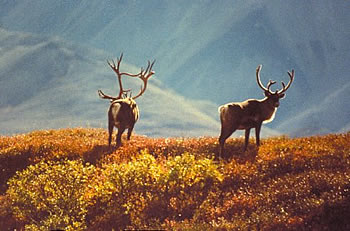
Arctic Tundra
The Arctic tundra, vast plains filled with grasses, flowers, mosses and lichen, is located due north of the taiga forests in Earth�southward northward polar region. Like all types of tundra, this is a very common cold and windy...more than
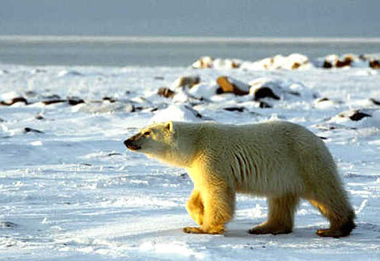
The Arctic: World's North Polar Region
North of the Chill Circumvolve (at 66.5�North breadth) you will find the Chill Ocean surrounded past the continents of Europe, Asia, and North America. You will notice the geographic Due north Pole and the magnetic...more than
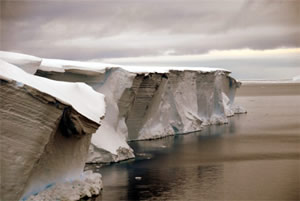
The Cryosphere
Frozen water is found in many different places on Earth. Snow blankets the footing at mid and high latitudes during winter. Ocean ice and icebergs bladder in the chilly waters of polar oceans. Ice shelves fringe...more

Kingdom Plantae
Kingdom Plantae contains about 300,000 unlike species of plants. It is not the largest kingdom, but information technology is a very of import one! In the process known equally "photosynthesis", plants use the energy of the...more
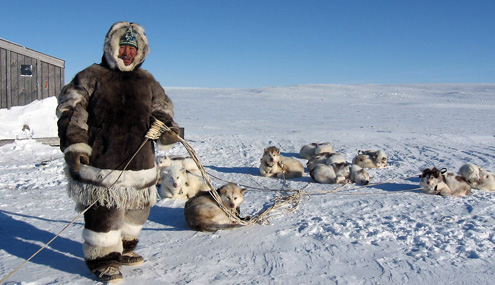
Inuit Culture in a Warming Arctic
The Arctic is warming quickly, faster than other places on Earth. Inuit people who live there have been noticing the change.� Because their culture is adapted to the Arctic�s cold climate, global warming...more
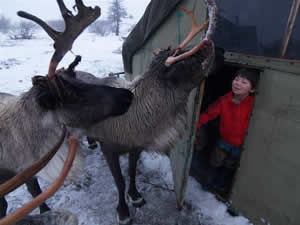
Arctic Cultures
There are people of different cultures and backgrounds who live in the Arctic region. Read on to learn more about two of these cultures. Inuit The Inuit are the native cultures that proceed to live on...more
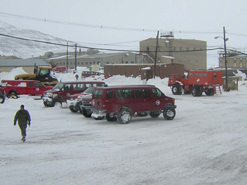
Exploration of the Poles of the Earth
Polar exploration includes the physical exploration of the Chill and the Antarctica. The Arctic is the area around the Globe's n pole and includes parts of Canada, Greenland, Russia, the United States...more
Source: https://windows2universe.org/earth/polar/inuit_culture.html
0 Response to "What Was the Art Like for the Ancient Inuit Peoples"
Postar um comentário